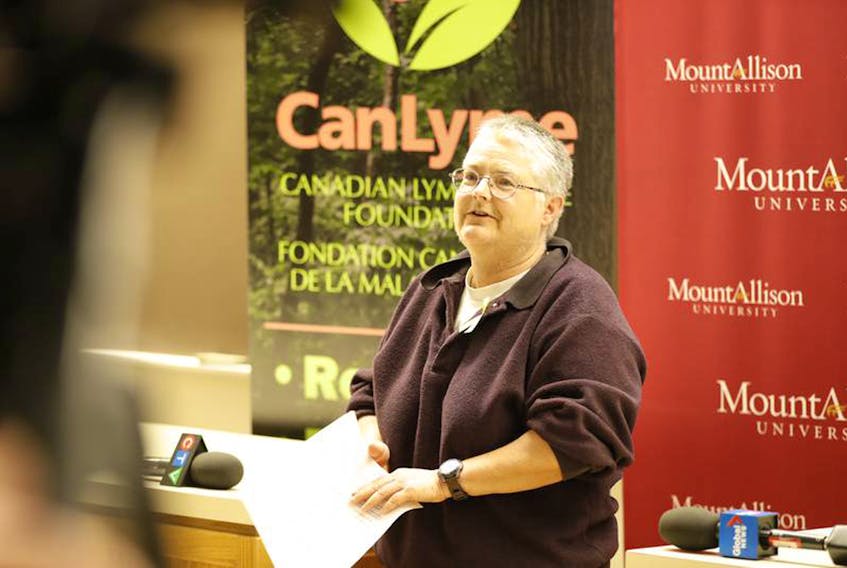SACKVILLE, N.B. – A Mount Allison professor and researcher feels it would be a good idea for Amherst to warn its residents about the presence of black-legged ticks in its parks and green spaces.
“It’s no secret there are ticks in Amherst just as they are in Sackville,” Dr. Vett Lloyd told the Amherst News. “Just like you’d warn people about other hazards, it wouldn’t hurt to let people know there are ticks so they will have in the back of their mind and perhaps at the end of the day they can check themselves and their children to see if anything got onto them.”
Lloyd, a founding member of the university’s Lyme Research Network, said the number of ticks has been increasing in recent years thanks to global warming. She says communication and education around ticks and the bacteria they can carry such as those that cause illnesses such as Lyme disease, is essential for public health.
Over the past few years, researchers in Lloyd’s lab have teamed up with veterinarians across the Maritimes to get a better idea of ticks and tick-borne illnesses including Lyme disease in the region.
They have collected and tested hundreds of specimens and have even established a Maritime Tick Portal (http://www.maritimetickmaps.ca/) a mapping resource to help share the latest information on ticks and Lyme disease in the region.
In Nova Scotia, the Department of Health and Wellness has designated most of northern Nova Scotia, including Cumberland and Colchester counties in the high risk category, while Lloyd said in New Brunswick, their research has indicated ticks are established pretty well everywhere in the province - and Sackville is no exception.
Lloyd said the most problematic areas seem to be the parks and the green spaces, particularly locations like Beech Hill Park, the Sackville Waterfowl Park and the rough areas of the town’s golf course. She same there would be similar conditions in parks on this side of the border.
“There are a lot more of the ticks that carry Lyme disease and there are a lot more that are infected,” she said. “You certainly have ticks and a lot of them are infected with the Lyme disease bacteria.
Lloyd isn’t sharing the news in hopes of scaring people. Instead, she wants people to educate themselves and be more aware when they are in areas where black-legged ticks may be found such as in long grass, shrubs or wooded areas.
“If you’ve been out in the park, hiking in wooded areas or gardening, at the end of the day take your clothes off and have a look at your body,” she said. “It may look like a freckle with legs. The sooner you get it off you the less likely you are to be infected.”
Lloyd said a tick usually has to be attached to a person for at least 24 hours to transmit Lyme disease.
She said it’s important to remove the tick’s entire body and said there are many tools out there to do that effectively. Something as simple as a pair of tweezers may be the most effective tool.
Lloyd, who spoke to Sackville’s town council recently asking for signage in town parks, said the situation is only going to worsen since not only do the ticks seem to be getting heartier, and not dying off during harsh winters like they used to, but there are also many other species of ticks that are being carried in to North America on migratory birds.
“They really like it here unfortunately.”
Lloyd said towns like Sackville and Amherst should be proactive in putting up signs, to let people know there are ticks around. She doesn’t think the signs would deter people from using the parks but it would provide them with the information they need to take the proper precautions.
Lloyd said there’s no proven way to get rid of ticks or to spray for them so the best option at this point is to simply let people know of their presence and the risks associated with them.
She said the biggest problem with ticks is that they don’t just suck your blood like mosquitoes, but they can bury into your skin and then “squirt the diseases they carry in their gut into your bloodstream and then you get sick.” Lyme disease is the most common of those tick-borne diseases. Of the specimens she has been sent, from both humans and pets, Lloyd said about 18 to 20 per cent are infected with Lyme disease.
And while there are plenty of tips out there about how to protect yourself against Lyme disease, Lloyd said she understands it’s not always possible to go out in the summer fully clothed with long sleeves and pants and your socks tucked into your pants, unless you regularly work in the woods.
But when heading to an outdoor area for recreational use, Lloyd said people want to be more comfortable. So, she advises everyone to perform a tick check when returning home.
(With files from Katie Tower, Sackville Tribune-Post)
Twitter: @ADNdarrell









